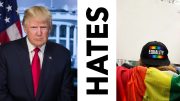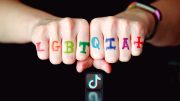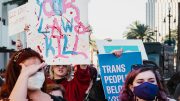In the majority of states, LGBT people and their families would still face legal discrimination
If the United States Supreme Court grants same-sex couples the freedom to marry, the majority of those couples will still face significant legal discrimination. According to a new report released today by the Movement Advancement Project (MAP), 61 percent of the lesbian, gay, bisexual, and transgender (LGBT) population in the U.S. will continue to live in states with medium or low legal protections—or that have outright hostile laws.
Mapping LGBT Equality in America tallies 34 existing laws and policies pertaining to the LGBT population and uses those tallies to place states into four categories:
- High Equality States: 12 states & D.C., 39% of the U.S. LGBT population
- Medium Equality States: 10 states, 9% of the U.S. LGBT population
- Low Equality States: 13 states, 23% of the U.S. LGBT population
- Negative Equality States: 15 states, 29% of the U.S. LGBT population
California has the nation’s highest level of equality for LGBT people with a tally of 29.25 out of a possible 34, while Louisiana’s negative laws result in the nation’s lowest tally (-6 out of 34). The report is available at www.lgbtmap.org/equality-maps. [pullquote]California has the nation’s highest level of equality for LGBT people with a tally of 29.25 out of a possible 34, while Louisiana’s negative laws result in the nation’s lowest tally (-6 out of 34).[/pullquote]
IMPACT OF A U.S. SUPREME COURT MARRIAGE RULING
In June, the U.S. Supreme Court could extend the freedom to marry to same-sex couples throughout the nation. Yet the report finds that the majority of those couples would still face legal discrimination simply for entering into the lifelong promise of marriage:
- 52% of LGBT people would be at risk of being fired from their jobs, kicked out of their homes, or denied access to doctor’s offices and restaurants.
- 86% percent of LGBT people would live in states where their child is not protected from discrimination in school for having LGBT parents.
- 81% of LGBT people would live in states where harmful “conversion therapy” is still permitted.
- The number of LGBT people living in states with high and medium overall equality would remain unchanged. Rather, 12 states would shift from negative equality states to become low equality states.
“Without question, a victory at the Supreme Court would be a transformative in helping advance equality for LGBT people,” said Ineke Mushovic, Executive Director of MAP. “However, many other laws are needed to fully protect LGBT people and their families. For example, while same-sex couples may soon be able to marry in their home state, that same state’s laws may fail to protect LGBT youth from being bullied in schools, lack nondiscrimination laws covering LGBT workers, or lack laws and policies that help transgender people update the gender marker on their identity documents. One state may have high equality while a neighboring state has hostile laws. Or, a state may have high levels of equality for gay, lesbian and bisexual people while offering almost no legal protections to transgender people.”
PROTECTIONS FOR TRANSGENDER PEOPLE
Mapping LGBT Equality in America also shows how protections for LGBT Americans vary based on sexual orientation and gender identity/expression. Among the key findings:
- Almost double the number of lesbian, gay and bisexual people live in states with high tallies for sexual orientation protections (45%) than transgender people who live in states with high tallies for gender identity protections (28%).
- Almost double the number of transgender people (37%) currently live in states with negative tallies for gender identity protections that the number of lesbian, gay and bisexual people who live in states with negative tallies for sexual orientation protections (20%).
- A Supreme Court decision granting nationwide marriage to same-sex couples would reduce the number of states with a negative sexual orientation tally to zero, but 37% of transgender people would continue to live in states with negative tallies for gender identity protections.
“Most Americans do not personally know someone who is transgender, and therefore there is often less understanding of the added legal barriers and discrimination transgender people can face,” said Ineke Mushovic, Executive Director of MAP. “From health insurance discrimination that denies transgender people medically-necessary care to unnecessary barriers to changing the gender marker on driver’s licenses, transgender people often live in states with laws that compromise their health, employment, ability to rent an apartment, and more.” [pullquote]“From health insurance discrimination that denies transgender people medically-necessary care to unnecessary barriers to changing the gender marker on driver’s licenses, transgender people often live in states with laws that compromise their health, employment, ability to rent an apartment, and more.”—Ineke Mushovic, Executive Director of MAP[/pullquote]
Mapping LGBT Equality in America also:
- Introduces the major state and local laws and policies that protect or harm LGBT people.
- Provides a comprehensive breakdown of those laws and policies by state.
- Examines laws that specifically aim to harm or restrict equality for LGBT people.
In a rapidly changing legal landscape, MAP’s LGBT Equality Maps track LGBT equality, populations, and other data by state. Maps are updated daily as changes in law, policy, and legislation occur. All Equality Maps, including high-resolution JPEG versions, are available for publication. The LGBT Equality Maps allow websites to embed the maps easily and for free. Visit lgbtmap.org/equality-maps to learn more.
Founded in 2006, the Movement Advancement Project is an independent think tank that provides rigorous research, insight and analysis that help speed equality for lesbian, gay, bisexual and transgender people.
[From a Press Release]








